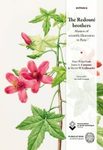About this book
In Crocologia: A Detailed Study of Saffron, the King of Plants, Sally Francis and Maria Teresa Ramandi present the first translation into English of Johann Ferdinand Hertodt’s seminal 1671 work Crocologia, a book uniquely devoted to the medical uses of saffron. Hertodt discusses saffron’s origin, related species, cultivation, selection, properties and lists all its pharmaceutical preparations. Hertodt then journeys through diseases of the human body, presenting saffron-containing formulae for their treatment.
The two authors complement the translation with a biography of Hertodt, and detail saffron’s botany, current production, uses, its changing reputation as a drug, and review findings from new medical research. There is a full Glossary, and translation of a contemporary animadversion of Crocologia by Hertodt’s rival, Wenzel Maximilian Ardensbach.
Contents
Acknowledgments
List of Figures
Introduction
1 Crocologia and Its Author
2 Saffron
3 Saffron in Orthodox European Medicine after Crocologia
4 Conclusion
Notes on Our Translation Methods
Translated Text
Frontispiece, Title Page, Dedications, and Cabalistichon
I Etymology and Description of the Saffron Crocus. (Where Do Names Come From? Origin of the Name Crocus. What Is Saffron?)
II Attributes, and Species, of Saffron. (This Chapter Describes Saffron, Autumnal & Vernal Wild Crocus Species, plus also Safflower)
III Native Place, and Time When Saffron Emerges and Flowers
IV Cultivation of Saffron. (Preferred Soil, How Planted and When, Means of Destroying Mice & Moles, Mouse-Traps, Recipe for “Multiplicative Solution”)
V Selection of Saffron. (Methods of Adulteration & How to Spot Them, Places That the Best Saffron Comes From)
VI Properties of Saffron. (Virtues of Saffron, Effects of Overdosing, Death of Pack-Horses Carrying Lots of Saffron)
VII Uses of Preparations of Saffron. (Exhaustive Descriptions of Recipes: Two Culinary Recipes; The Rest Are for Specific Medicinal Preparations of Saffron Ranging from Spirit of Saffron to Elaeosaccharum of Saffron. Notes with the Recipes of Which Diseases the Different Preparations Can Be Used For. Interesting Uses for Whole Saffron-Flowers and for Corms)
IIX Diseases of the Brain. (Sections Describing Symptoms & Causes, Associated Folklore, plus Suitable Recipes [Including Saffron] for Treating: Cephalgia or Headache, Paralysis, Vertigo, Epilepsy, Lethargy, Amnesia, Incubus, Catarrh, Agrypnia or Wakefulness, Phrenitis, Mania)
IX Diseases of the Eyes. (Same Format as Above: Ophthalmia, Cataract or Opacity of the Cornea, Phlyctens, Ungula, Aegilops, Procidentia of the Eye, Swelling of the Eyelids)
X Diseases of the Ears. (Same Format: Deafness, Tinnitus, Earache, Parotitis, Ear Discharges, Ulcer of the Ear)
XII [No Chapter XI in Original] Diseases of the Teeth and the Tongue. (Same Format: Odontalgia, Prunella, Paralysis of the Tongue)
XIII Diseases of the Chest. (Same Format: Angina, Asthma, Coughs, Phthisis, Pleurisy, Pneumonia, Empyema)
XIV Diseases of the Heart. (Same Format: Syncope, Heart Palpitations)
XV Diseases of the Stomach. (Same Format: Heartburn, Anorexia or Inappetence, Hiccups, Nausea)
XVI Diseases of the Intestines. (Same Format: Hernia, Worms, Blind Haemorrhoids, Bleeding Haemorrhoids, Dysentery, Tenesmus, Diarrhoea, Colic)
XVII Diseases of the Liver. (Same Format: Inflammation of the Liver, Hepatitis, Dropsy, Jaundice, Obstruction of the Liver, Distemper of the Liver)
XVIII Diseases of the Spleen. (Same Format: Obstruction of the Spleen, Hypochondria, Scurvy)
XIX Diseases of the Kidney and Bladder. (Same Format: The Stone, Urinary Retention, Impotence in Sexual Intercourse)
XX Diseases of Women. (Same Format: Sterility, Chlorosis, Menstrual Retention, Uterine Haemorrhoids, Hysteric Passion, Distokia or Difficult Birth, Pain after Childbirth, Mola, Retained Secundines, Retained Lochia)
XXI Fevers. (Same Format: Fevers, Plague)
XXII Diseases of the External Parts. (Same Format: Erysipelas, Arthritis, Tumour, Scrofula, Breast Inflammation, Burns, Gangrene, Ecchymosis, Wounds, Ulcers, Synovia)
XXIII The Mechanical Uses of Saffron. (Hair Dyes, Inks, Coloured Sugar)
Questions Concerning Saffron (I. Is Saffron a Remedy against Monkshood? II. Does Saffron Prevent Intoxication or, Rather, Cause It? III. Does Saffron Induce Sleep or Wakefulness? IV. Does Saffron Tinge a Foetus in the Womb?)
Illustration of Different Kinds of Crocuses, and Explicative Table
Appendix 1: Hertodt’s References
Appendix 2: Animadversion on Hertodt’s Crocologia by Wenzel Maximilian Ardensbach (1671)
Appendix 3: Glossary
Crocologia, Our References
Index
Customer Reviews
Biography
Sally Francis, M.A. (Oxon.), D. Phil. (Oxon., 1996) is a botanist, specialising in niche crops. For the last decade, she has concentrated on saffron, extensively researching the plant and becoming the UK’s leading commercial grower of the spice.
Maria Teresa Ramandi, PhD (Cantab., 2016) is a Latinist with an interest in the History of Medicine. Her research has focused on the circulation of Latin texts in Northern Europe and their translation into vernacular languages.














![Die Vogel-WG: Die Heinroths, ihre 1000 Vögel und die Anfänge der Verhaltensforschung [The Bird Wohngemeinschaft: The Heinroths, Their 1000 Birds and the Beginnings of Behavioral Research]](http://mediacdn.nhbs.com/jackets/jackets_resizer_medium/26/267983.jpg?height=150&width=107)



















